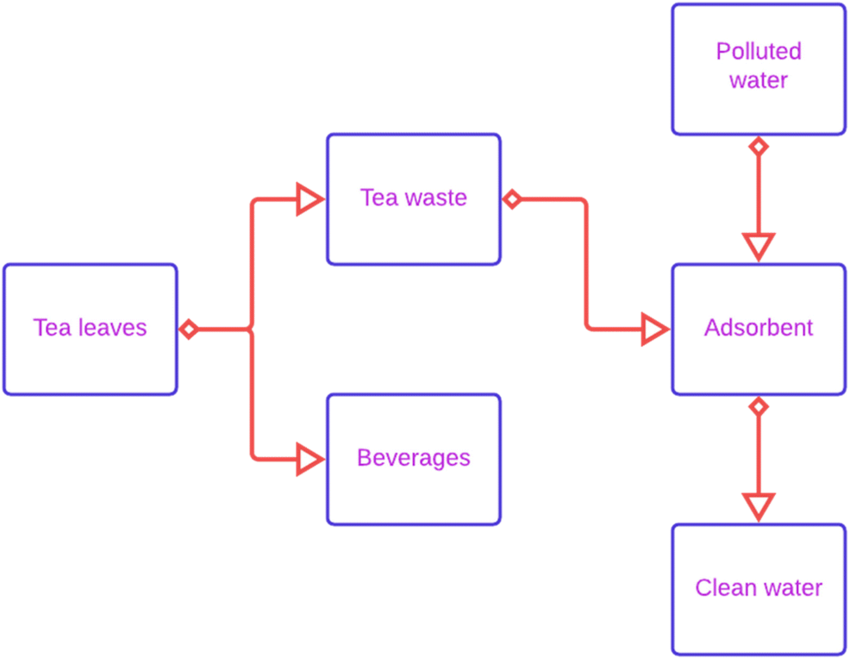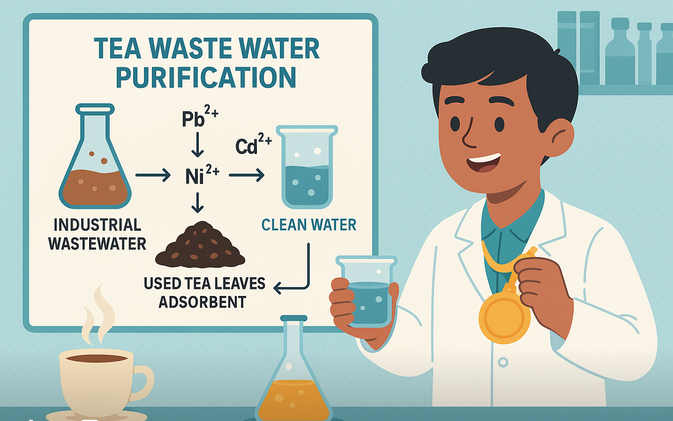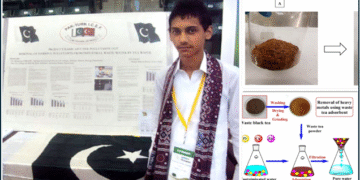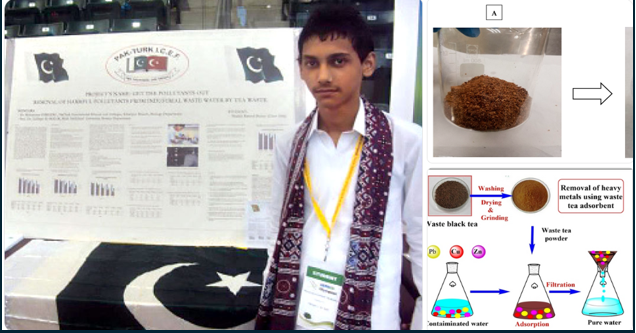They say a hot, sweet cup of tea can solve most problems — heartbreak, fatigue, or a long, tiring day. But few could imagine that tea, or more precisely used tea waste, might also help solve one of humanity’s biggest problems: access to clean water.
This idea, simple yet revolutionary, came not from a seasoned scientist or a high-tech lab, but from a young tenth-grade student from a small town in Pakistan — Shadab Rasool Buriro from the Pak-Turk International School in Khairpur. His project, which explored the potential of used tea waste to remove pollutants from industrial wastewater, earned him a silver medal at the GENIUS (Global Environmental Issues-US) Olympiad, hosted by the State University of New York (SUNY) at Oswego and the Terra Science and Education Foundation.
🌍 The Spark of a Young Mind
Every great discovery begins with curiosity. For Shadab, it started with a simple question — what if something as ordinary as used tea leaves could clean the water we drink? Living in a region where agriculture is the backbone of livelihood, he had seen firsthand how polluted water harms crops, soil, and eventually, people.
He decided to test an unconventional idea: using tea waste, which millions throw away daily, to remove harmful heavy metals and toxins from industrial wastewater.

⚗️ The Science Behind Tea Waste Purification
Shadab’s method was as creative as it was scientific. He collected used tea leaves, washed them with boiled water to remove all remaining color, and then dried them completely. These dried leaves became his experimental filter.
He then prepared solutions containing common industrial pollutants like cadmium, lead, nickel, and phenol — substances known to cause serious health and environmental problems. He mixed these solutions with the treated tea waste and allowed them to react for about an hour.
Then came the moment of truth. Using a spectrophotometer, he analyzed the filtered water samples to measure the remaining concentrations of the pollutants.
The results were remarkable. The tea waste had absorbed significant amounts of toxins, showing that this humble household material could, in fact, clean water — effectively and cheaply.
🏅 Recognition on a Global Stage
His project was first evaluated at the Pak-Turk School’s head office in Islamabad, and from there, it made its way to the international GENIUS Olympiad in the United States. Competing against brilliant students from over 50 countries, Shadab presented his research confidently before a panel of seven impartial judges.
To his surprise, and his country’s pride, he won a silver medal — a victory that proved that great innovation can come from anywhere, even from a tenth-grader with a few used tea leaves and a dream to make the world better.
A Hero in the Making
Shadab’s achievement didn’t go unnoticed. The Turkish government recognized his accomplishment and sponsored a 15-day visit to Turkey, where he was introduced as “the boy who competed against students from 50 nations.”
His proud parents — his father, Ghulam Rasool Buriro, a retired deputy district education officer, and his mother, Kaneez Panjtan, a district education officer — stood by his side throughout his journey. “My parents encouraged me. They helped me wherever it was possible for them to,” Shadab said humbly.
🌱 Tea Waste: The Unsung Hero of Sustainability
While Shadab’s project drew attention to Pakistan’s potential in sustainable science, the concept of using tea waste for water purification isn’t entirely new. Around the world, researchers have explored similar methods — and the results have been promising.
- In Kosovo, a paper published in the Journal of International Environmental Application & Science showed that used tea leaves could effectively remove phenol, a toxic industrial chemical, from wastewater.
- In South Africa (2010), researchers created a tea bag water filter — literally a tea bag filled with activated carbon molecules that can be fitted onto a bottle top to purify water as it’s poured.
- At Mehran University of Engineering and Technology, Jamshoro, chemical engineers successfully removed arsenic from contaminated water using tea waste, publishing their results in the Sindh University Research Journal.
- Similarly, in Iran (2007), four researchers documented the use of tea waste for the adsorption of heavy metals in the Iranian Journal of Environmental Health Science & Engineering.
Each of these findings reinforces a profound idea: that waste can become wealth, and the simplest materials can become solutions when combined with a curious mind.
💧 The Chemistry of Purification: Why It Works

The secret lies in adsorption, not absorption. Tea leaves contain polyphenols, tannins, and cellulose fibers — all rich in functional groups that bind to metal ions and organic pollutants. When industrial waste or contaminated water passes through treated tea waste, the harmful particles stick to the surface of the tea fibers, leaving behind cleaner water.
This process is cost-effective, natural, and scalable, making it a potential solution for developing countries struggling with water contamination.
🌿 From a Cup to a Cause
Imagine this: every cup of tea we drink could contribute to cleaner rivers, healthier crops, and safer drinking water. The same leaves that comfort us at dawn could also safeguard the next generation’s right to clean water.
Shadab’s story isn’t just about science; it’s about belief, curiosity, and the courage to question the ordinary. In a world dominated by billion-dollar technologies, he showed that real innovation often brews quietly — in classrooms, kitchens, and small towns where imagination knows no limits.
☀️ A Message to Young Innovators
In his own words, Shadab once said, “I was not expecting to get any position as other students were so confident and well-prepared.”
But he did win — not just the silver medal, but also hearts and hope.
His success is a reminder to every young dreamer that you don’t need a fancy lab to make a difference. All you need is a question worth exploring, a few materials within reach, and the determination to see it through.
🫖 The Future: Turning Waste into Wonder
Researchers worldwide are now exploring ways to industrialize this method, using tea waste in large-scale filtration systems. If successful, it could transform waste management, environmental cleanup, and even rural water purification programs.
As more young scientists like Shadab step forward, the world may finally realize that sustainability isn’t just about technology — it’s about rethinking what we throw away.
So, next time you finish your cup of tea, pause before tossing those leaves. Somewhere in that little pile of tea waste might lie the power to clean the world’s water — and maybe even win a global science award.
















